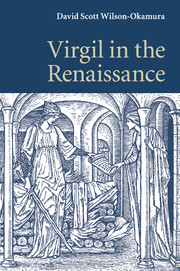Book contents
- Frontmatter
- Dedication
- Contents
- Illustrations
- Acknowledgements
- Texts and abbreviations
- Introduction
- Part I Publication
- Chapter 1 Virgil with an i
- Part II Reputation
- Part III Interpretation
- Appendix A Virgil commentaries in Latin editions, 1469–1599
- Appendix B Virgil commentaries ranked by number of printings
- Index
- References
Chapter 1 - Virgil with an i
from Part I - Publication
Published online by Cambridge University Press: 05 March 2014
- Frontmatter
- Dedication
- Contents
- Illustrations
- Acknowledgements
- Texts and abbreviations
- Introduction
- Part I Publication
- Chapter 1 Virgil with an i
- Part II Reputation
- Part III Interpretation
- Appendix A Virgil commentaries in Latin editions, 1469–1599
- Appendix B Virgil commentaries ranked by number of printings
- Index
- References
Summary
And how the same inexorable price must still be paid for the same great purchase.
Walt Whitman, “Beginners”Vergil or Virgil? The correct answer, as any Latinist can tell, is that the poet spelled his own name with an e: Vergilius. Where did the i come in? A scribe, taking dictation, hears the word Vergilius (which he has never seen before), and writes down the word Virgilius, which sounds right and starts in a familiar way, with the Latin word for man. Or perhaps he thinks of virgo, “virgin,” because Virgil was nicknamed Parthenias, “the virgin”; or of virga laurea, because according to legend Virgil’s mother dreamt that she gave birth to a laurel branch; or of virga populea, because Virgil’s mother is said to have planted a poplar branch to mark his birth-place. There were other stories as well. What concerns us here, though, is not how the confusion began, but why it has persisted.
Poliziano’s proof
In fact, the question was settled long ago, by a man who is universally recognized as the greatest classical scholar of the fifteenth century. His parents named him Angelo Ambrogini (1454–94), but his readers knew him by his Latin surname, Politianus, on account of his birthplace, Montepulciano. Poliziano, as he is known to us, entered the University of Florence at the age of ten, where he took up the study of Greek. At fifteen, he began to publish a Latin translation of the Iliad, which he dedicated to Lorenzo de’ Medici (1449–92). Seven years later, he entered the service of Lorenzo as a tutor to his children and began a long poem on Lorenzo’s brother, the famous Stanze per la giostra (1475). This was followed in 1479 by La favola d’Orfeo, the first pastoral drama in Italian literature and a precursor of the modern opera. So much for his hobbies. What set Poliziano apart from his learned contemporaries was his detailed knowledge, unprecedented and unparalleled, of Latin literature, its Greek models, and the ancient scholia; his sustained interest, not only in Greek literature from the classical period but also from the Hellenistic period (as we now call it); and, most important, his methodical approach to textual criticism: not only collating the extant manuscripts, but organizing them into families.
- Type
- Chapter
- Information
- Virgil in the Renaissance , pp. 15 - 44Publisher: Cambridge University PressPrint publication year: 2010



